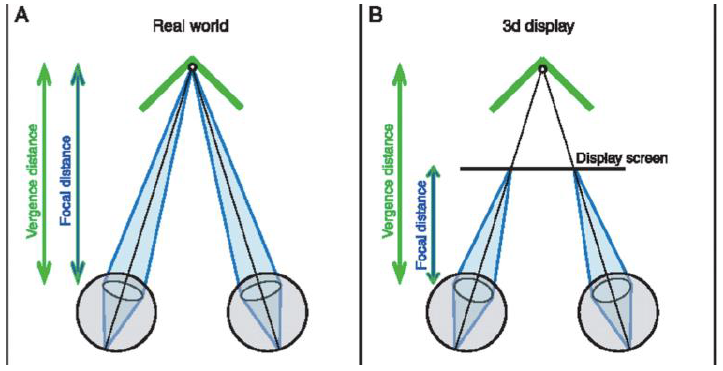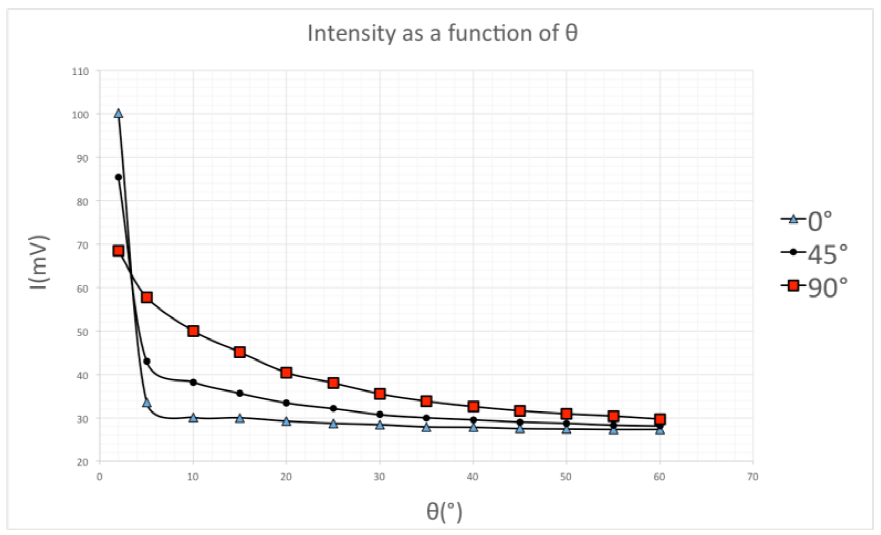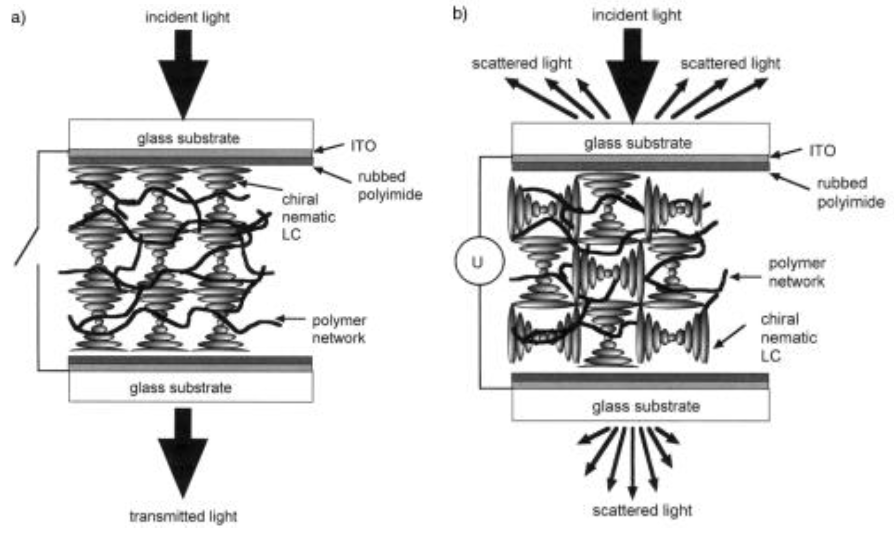1 Introduction
New emerging technologies such as virtual reality (VR) and augmented reality (AR) have been widely utilized from movies to medical purpose. However, these technologies exhibit a state of the art problem [1].
Human vision is binocular, which means that our eyes collect information from the environment to recognize whether the object is in 3D. For our eyes to see an object sharply focused on the retina, the ciliary muscle changes the shape of the crystalline lens to match the effective focal distance [3]. However, Depth perception is obtained from different cues [2].
One of them is the eyes accommodation mechanism, the angular resolution between the two eyes, that is is solved in order to fuse images. Each eye saves a different image of the same scene, those images must be converged to a distance close to the object distance.
This mechanism is known as vergence. Our eyes and brain are constantly solving accommodation and vergence in order to obtain information about depth, distance, etc. This is depicted in Figure 1.a. If it is not solved, the eye-brain conflict is known as accommodation-vergence conflict [4]. This conflict arises when using stereoscopic 3D displays. In a stereoscopic 3D display, the focal distance is fixed thus; the eyes can no longer solve at the same time the vergence-accommodation as depicted in Figure 1.b. This will result in strain, dizziness and health problems to the eye.

Fig. 1 Human vision is stereoscopic. a) How the human eyes can see by solving vergence and accommodation. b) How 3D displays actually work, causing conflict in the eyes [3]
The images displayed on a multi-plane display, have distances that match the corresponding retinal images of the input scene as closely as possible.
Recent research has shown that multi-plane display based on liquid crystal can potentially improve the vergence-accommodation conflict. A multi-plane display, exhibits images that are drawn on presentation planes at several different optical distances for each eye, enabling both vergeance and accommodation cues [5-7].
2 Polymer-Liquid Crystal Dispersions
Liquid crystals have been broadly applied for display technology in many branches of entertainment industry, medicine and basic scientific research. Their electro-optics properties are quite useful and appealing due to the facility of producing such materials. Although there are too many types of liquid crystal displays, the purpose of building a multi-plane display is to employ a LC cell, which can be switched back and forth from a transparent to a scattered state [8, 9].
A polymer-Liquid Crystal Dispersion is the ideal kind of LCD that can achieve that goal. There are two types of polymer liquid crystal dispersion though. A Polymer dispersed liquid crystal (PDLC) is a composite material where the host of the mixture is a polymer solution (~70%) and is doped with LC droplets [7]. The operation principle of a typical PDLC device is opaque in the field-free state, the LC cell is a strong light scatterer, and transparent when in the field-on state due to a reorientation of the director vector in each droplet.
However, this not convenient for our, and other optoelectronic, purposes. A completely opposite functioning structure is the polymer-stabilized liquid crystal (PSLC). This composite is a cross-linked polymer (~5%), sometimes called a monomer. In this configuration, the applied voltage to switch from the two states is relatively lower than in a PDLC [8, 9]. The other advantage that the PSLC has over PDLC is in the operation modes. PSLC exhibits two modes; a normal and a reverse mode. In the normal mode, LC cell becomes transparent on the field-on state and scatters light on the field-off state. On the other hand, on the reverse mode, the LC cell is transparent on the field-off state and scatters light on the field-on state.
3 Polymer Stabilized Cholesteric Liquid Crystal
The difference between a normal mode and a reverse mode on a PSLC consists on the pitch. For a normal mode, the pitch is on the range of (~0.5 - 5μm) and for a reverse mode the range goes (~3- 151μm) [12]. As its name suggest, a PSLC is a composite made of a polymer. The polymer network is of great importance, for it stabilized the LC director after applying an electric field, i.e., it is possible to change from a transparent state to an opaque one, without breaking the anisotropic molecular order [8].
To create a polymer network, we use a mixture of chiral liquid crystal (a nematic LC doped with chiral molecules) and a monomer.
This monomer will copy in the same fashion, the helical structure of the cholesteric LC. When a PSLC is created using a cholesteric LC, is called a polymer-stabilized cholesteric Texture (PSCT) [14].
The building process for a PSCT LC cell is as follows. First, we employ E7 nematic LC as the host of the mixture (Merck company), with the 92.7% weight. After that, we added some chiral components R811 with a weight percentage of 2.8%. Since the whole mixture is going to be exposed to UV-light to create a polymer network, thus we need a monomer (after the UV curing will be a polymer) RM257 with 4.0% total weight.
Just to ensure the polymer network, we blend the mixture with less than ~0.5 wt% photo-initiator Irgacure 651, so it can be sensitive to UV. The mixture was heated to 100°C and stirred for several minutes to ensure the components were well mixed. It was then filled into a 15 μm ITO-cell by capillary action.
After that, it was exposed to UV light at 8mW/cm 2 for 30 min. Different mechanisms exist to create the polymer network. In some cases the LC cell is irradiated with UV curing, at the same time is heated. This takes a long time, which new research for techniques to make the polymerization have been studied [8,15].
As mentioned in the introduction of this work, we want a multi-plane display, which means the PSCT LC cell must be highly scattering depending on the angle. We measure the intensity of the cell as a function of the angle. First, the laser light passed through a polarizer at 0°, 45° and 90°. For each angle of polarization the PSCT LC cell had an angle with respect to a fixed photodetector.
The results are shown in Figure 2. We can learn from the plot the following.

Fig. 2 Plot of the measure intensity by changing the angle of incidence. The PSCT LC cell is shined with He-Ne laser light in the visible wavelength. The intensity reaches its minimum when the angle increases. Each angle is relative to a polarizer in the set up
The PSCT LC cell highly scatters light as the angle between the cell and the photodetector increases. This makes it suitable for applications such as a multi-plane display. The set up depicted in Figure 3 is utilized to measure the transmittance of the PSCT LC cell.

Fig. 3 Schematics for the set up to measure the transmittance of the PSCT LC cell. a) He-Ne laser with a wavelength λ = 632Snm. b) A pinhole for spatial cleaning. c) a polarizer. d) PSCT LC cell and a e) photodetector
A plot of transmittance vs voltage is useful because we can obtain information of the transmittance. To measure the transmittance against the voltage applied to the LC cell, we use a He-Ne laser as the source of light. Before the laser light shines on the PSCT LC cell, it passed through a polarizer. According to [16] the helix structure and the chirality in a Cholesteric Liquid Crystal, allows optical activity. However, this will be true if the order of the wavelength matches the pitch of the helix. In this case the pitch is in the order of (8 - 15μm).
In Figure 4, it is noticed the molecular arrangement of a cholesteric liquid crystal. The polymer network plays an important role to stabilize the structure.

Fig. 4 A polymer network in a cholesteric LC. The network stabilizes the orientation and direction of the molecules for a reverse mode. a) In the field-off state the LC cell is transparent. b) The LC cell scatters light due to the mismatch in the index of refraction of the LC; it is opaque to light [8]
At three polarization angles 0°, 45° and 90°, the Voltage-transmittance plot suggest the following. 0° stands for the ordinary ray and 90° for the extraordinary ray. It shows that at this chiral concentration, the scattering is highly linearly polarized. That reveals the adiabatic following effect that prevents the scattering of the other polarization state. This implies that the scattering of the PSCT is dominated by the index mismatch between polymer and LC molecules Figure 5.
4 Conclusion
We clearly see that the method of UV curing can achieve a polymer network in the mixture. This network allows the switch-like response of the LC cell when an external electric field is applied. The switching behavior of a reverse-mode PSCT cell is quite efficient since it does not need a large applied voltage compare to a normal-mode or to a PDLC. In addition, it is clear that the concentration of monomer and its intrinsic characteristics may improve the performance of the LC cell. The PSCT switches quickly between a transparent state and a scattering state within 1.5 ms. The switching behavior and the response time for the PSCT, makes it potentially useful for a multi-plane display application and further use in VR/AR technology.











 text new page (beta)
text new page (beta)



